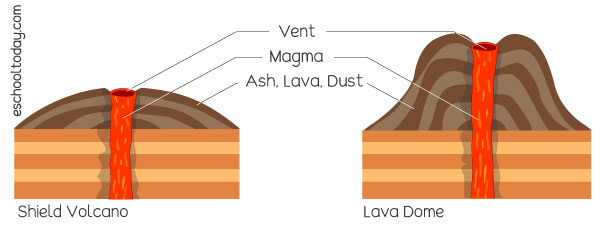- Volcanoes
Common types of volcanoes
Now, let us see the four common types of volcanoes: Shield volcano and lava domes, cinder cones, and composite volcanoes.
Shield Volcanoes
This is very fluid lava, usually from multiple vents or fractures, spreading over large areas. The fluid-like nature (viscous – say veez-kos) of the lava does not allow it to pile up like a cone. The result is usually an elevation with a shape like a warrior’s shield. Mount Kilauea and Maunaloa in Hawaii are good examples of shield volcanoes. They are usually found at constructive or tensional boundaries.
Lava Domes
They are produced from eruptions with less viscous lava. Because it is less viscous, they do not spread far and cool off (hardens) sooner. This means they pile around the vent and the dome grows only because of the expansion of the vent area within. Lava domes tend to have steep walls and rock types such as andesites, dacites, or rhyolites (say rai-o-lites)
Cinder Cones
These are the most common in the study of volcanoes. When lava is ejected into the air above, the fragments and fine particles fall as cinders (ash) around the vent, forming a cone. The height of cinder cones usually depends on how long the eruption takes and how much lava comes out. The cone has a depression (crater) in the middle where the vent is. Cinder cones can rise as high as 1200ft. An example of a cinder cone is the Paricutin Volcano in Mexico.
Composite Volcanoes
These are usually awesome, rising to about 8000ft. They are also known as stratovolcanoes and they include Mount Cotopaxi in Ecuador and Mount Fuji in Japan. They are seen as massive mountains. They are formed by alternating layers of ash, rock, dust, and lava (pyroclastic), and hence the name ‘composite’. They have steep slopes with a peak.
